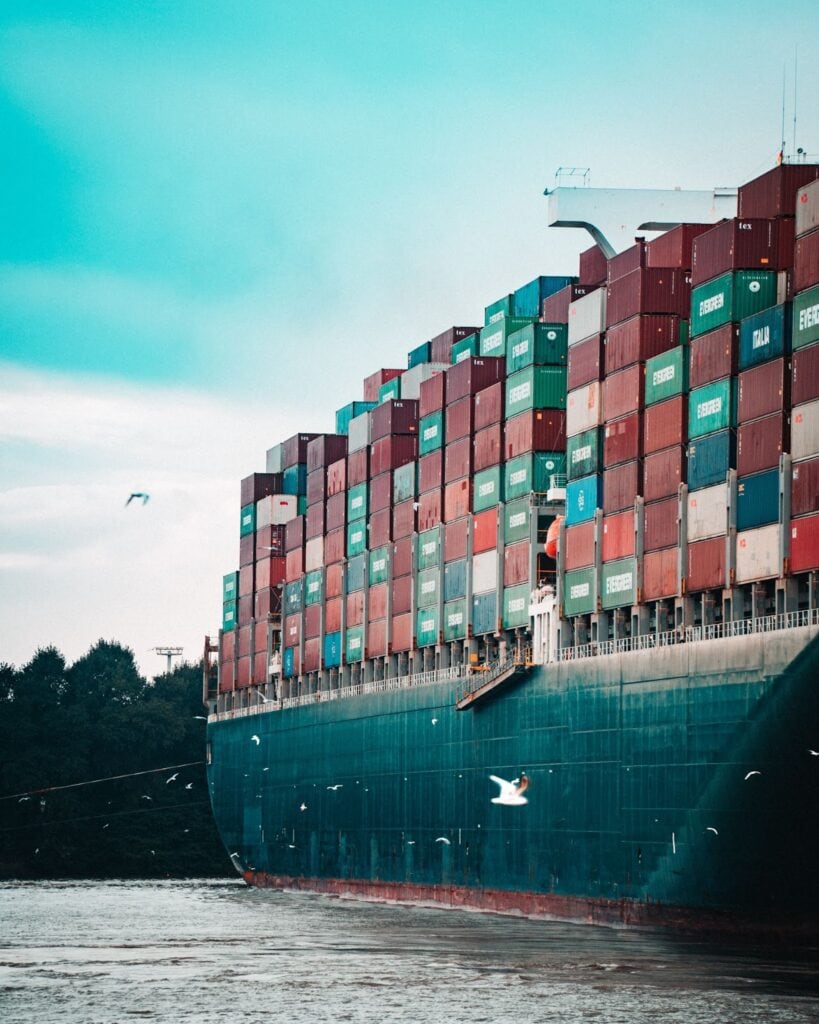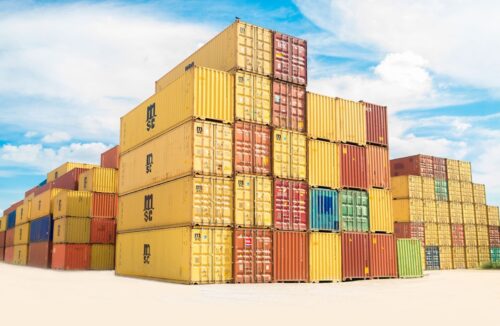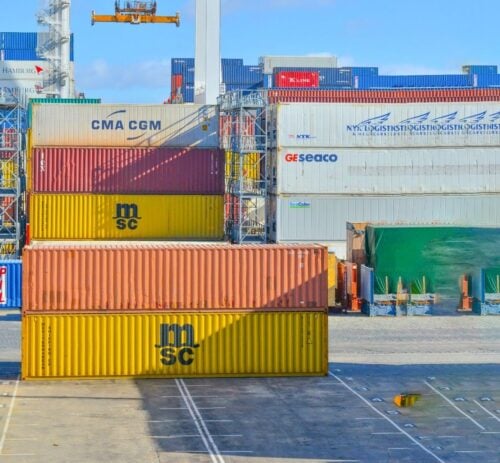Containerization of Shipping Containers: Definition, Types, and Process

In this comprehensive guide on containerized cargo, including definitions, types, and process, we will explore its vital role in global trade.
As a professional interested in containerized cargo, you’ll find valuable insights into different types of containers and their specific uses within the supply chain. We will also discuss the intricate process involved in handling these containers at various stages of transportation.
Furthermore, we’ll examine the advantages that have made containerized cargo a dominant force in both international trade and logistics while addressing some challenges and considerations businesses face today. Finally, we look at future trends and innovations shaping this industry and answers to frequently asked questions about containerized cargo.
Introduction to Containerized Cargo
Containerized cargo has revolutionized the shipping industry, making transporting goods worldwide more manageable and efficient. The concept of containerization involves using standardized containers to pack and ship various products, simplifying logistics processes and reducing costs. This article investigates the development of containerization, its impact on global commerce, and how it has changed over time.
The idea of using containers for transportation dates back to the early 20th century when railway companies started utilizing wooden boxes to carry and protect fragile items during transit. Malcom McLean’s invention of intermodal shipping containers in the mid-1950s revolutionized global trade by allowing easy transfer between trucks, trains, and ships without unloading cargo.
This innovation transformed global trade by significantly increasing efficiency while reducing labor costs associated with loading and unloading cargo tank containers at each stage of transportation. Today, 90% of non-bulk cargo worldwide is transported via containers, highlighting their importance in facilitating international commerce.
History and Development
Containerization owes its inception to Malcolm McLean, a trucking magnate who envisioned a seamless transport system dependent on container load. In the 1950s, he pioneered the development of the first standardized containers, which later became the cornerstone of global shipping, making it more efficient and interconnected.
It’s fascinating that before McLean’s innovations, goods were laboriously loaded and unloaded onto ships piece by piece. McLean’s vision created the “Intermodal System,” where containers could move seamlessly across different transport modes. This reduced product damage and pilferage and cut the costs and time associated with manual loading.
Vessel Capacity
The size and capacity of vessels underwent a significant transformation post-containerization. Ships expanded to container load, leading to ‘mega-ships.’ These behemoths, which can carry over 20,000 twenty-foot equivalent units (TEUs), now dominate major shipping routes.
The modern design of these mega-ships optimizes space usage, allowing for higher cargo loads. Enhanced storage capacities mean fewer trips for the same volume of goods, reducing fuel consumption and overall emissions per container basis.
Logistics
Containerization streamlined logistics by standardizing cargo handling. This uniformity ensured reduced loading and unloading times, minimized errors, and simplified warehousing and inventory management, leading to a more agile and cost-effective supply chain.
An agile supply chain brought about by containerization provides competitive advantages to businesses. Faster shipping times mean products reach markets quicker, enhancing profitability. Moreover, reducing shipping errors translates to enhanced brand reputation and trust.
Major Port Hubs
With the rise of containerization, ports had to adapt swiftly. Major hubs like Shanghai, Singapore, and Rotterdam expanded their infrastructures to handle the burgeoning container traffic, establishing themselves as the primary conduits of global trade.
A simple container ship can take up an enormous amount of space in the harbor. Appropriate equipment is needed to manage the full container load of a container shipping line.
The strategic importance of these port hubs goes beyond their shipping capacities. They often dictate global trade routes, influence shipping costs, and play pivotal roles in international geopolitics.
Container Ships Today
Modern container ships are marvels of engineering. Enhanced with advanced navigation systems, optimized hull designs, and eco-friendly technologies, these vessels transport vast quantities of goods with increased efficiency and reduced environmental impact. The modern container ship can take on the full container load of several traditional cargo ships.
Given the increasing environmental concerns, many shipping companies are also adopting alternative fuel sources, like LNG (Liquefied Natural Gas), to power these massive vessels, showing a commitment to sustainable practices.
Importance of International Trade
Containerization has been a catalyst for international trade growth. Intermodal containers democratized trade by simplifying cargo handling and reducing transport costs, enabling even smaller nations to participate in the global market, thus fostering economic interdependence and cooperation among countries.
The ripple effects of this economic interdependence are profound. Nations become stakeholders in each other’s prosperity, often leading to more stable international relations. Moreover, this interdependence has made economies more resilient to regional shocks.
Types of Containers

Different types of containers are available for the transportation of different goods worldwide. Let’s look at common container types and their uses in containerized cargo.
Dry Containers
Dry or general-purpose containers are the most commonly used type for storage and transporting a wide range of products. These enclosed steel or aluminum boxes come in standard sizes, such as 20-foot and 40-foot lengths.
They provide ample space for non-perishable items like clothing, electronics, furniture, and machinery parts. In addition, their waterproof design protects the cargo from external elements during transportation.
Refrigerated Containers
Refrigerated containers, or reefers, are essential in preserving perishable goods like fruits, vegetables, meat products, and pharmaceuticals throughout their journey.
Equipped with temperature control systems that maintain specific temperatures (usually between -25°C to +25°C), these specialized units ensure optimal conditions for sensitive commodities susceptible to spoilage due to heat or humidity fluctuations.
Flat Racks
Flat racks provide flexibility and capacity when handling oversized or irregularly shaped cargo that cannot fit into standard dry containers. A flat base with collapsible end walls on either side can accommodate heavy equipment such as construction materials or large vehicles by allowing easy loading from above using cranes or other lifting equipment.
Open Tops
Open-top containers are similar to dry containers but without a fixed roof, making them ideal for transporting tall or bulky items that cannot be loaded through the doors of regular units.
A removable tarpaulin cover and securing ropes protect the cargo from weather elements while providing easy access during the loading and unloading. Typical uses include shipping machinery, timber logs, and large sculptures.
Containerization Process
The containerization process is a crucial aspect of transporting goods efficiently and securely. It involves several steps, including loading, securing, and unloading the cargo.
Loading
Loading refers to placing goods into empty containers for transportation on container ships. This step requires careful planning to ensure that items are correctly arranged within the container to maximize space utilization while maintaining stability during transit.
Proper loading techniques make sure there is a full container load and also help prevent damage caused by shifting or falling cargo. For example, heavier items should be placed at the bottom with lighter ones on top to maintain balance throughout transport.
Securing
Securing cargo inside containers is essential for preventing movement during transportation and reducing potential damages. Different types of freight necessitate various securing techniques, such as lashing straps, chains, ropes, specialized locking systems, or dunnage materials.
Some standard securing methods include using lashing straps, chains, cords, or technical locking systems designed specifically for different types of containers (e.g., flat racks). Additionally, dunnage materials such as airbags or foam blocks may be used between cargoes to fill empty spaces and provide cushioning against shocks encountered en route.
Unloading
The final stage in the containerization process is unloading – removing goods from their respective containers upon arrival at their destination port or warehouse facility. This step must be executed carefully, as improper handling could damage both products and equipment involved in lifting operations (such as cranes).
Furthermore, efficient unloading container shipping practices can significantly reduce port turnaround times – allowing vessels to depart sooner for their next voyage, thus improving overall supply chain efficiency.
Advantages of Containerization

Using standardized shipping containers has significantly improved the efficiency of global trade by streamlining loading and unloading processes. In addition, with container ships designed to accommodate specific sizes and types of containers, it becomes easier for crane operators to move them on and off vessels quickly. This results in faster port turnaround times, ultimately reducing business transportation costs.
Before containerization, goods were often loaded individually onto ships – a process known as break-bulk shipping. However, this time-consuming method exposed cargo to potential damage from weather conditions or rough handling during transit between ports. Contrastingly, containerized cargo is securely packed within durable steel boxes that protect its contents from external elements while minimizing movement during transport.
Some of the safety and security enhancements include cargo tracking, tamper-proof seals, and risk mitigation, such as insurance coverage explicitly tailored for containerized cargo, ensuring that businesses are adequately protected against potential losses.
Challenges and Considerations
Containerized cargo has revolutionized the shipping industry, yet this technology also comes with its own set of obstacles to be aware of. These include proper packing, securing, labeling, and potential risks such as cargo damage, theft, or piracy.
Proper packing is essential to ensure that goods are not damaged during transportation. This involves using appropriate packaging materials like pallets or crates for heavy items to protect them from damage. Additionally, adequate securing measures must be taken to prevent the shifting of containers during transit. For instance, using lashing bars or strapping can help keep containers in place on a ship’s deck.
Correct labeling is crucial in ensuring smooth handling throughout the supply chain process. Each container should have clear labels displaying information such as contents description, destination port code, and consignee details. Failure to provide accurate information may lead to delays at customs checkpoints or misrouting of shipments.
There are always cargo damage risks including mechanical issues, natural disasters, and improper or rough port handling.
Theft and Piracy Concerns
Despite enhanced security measures, containerized cargo remains vulnerable to theft and piracy. Thieves target high-value goods such as electronics or luxury items, while pirates often hijack entire ships for ransom. To mitigate these risks, businesses should consider implementing additional security measures, like employing armed guards on board or using advanced tracking systems.
The challenges and considerations associated with containerized cargo are complex but can be managed with the right processes and procedures. Examining novel approaches that can facilitate processes while guaranteeing the merchandise’s security and protection is critical.
An Overview of Freight Services and Supply Chain
Freight services play an instrumental role in the global supply chain, ensuring that products move seamlessly from manufacturers to consumers across vast distances. These services encompass various modes of transportation, including sea, air, rail, and road.
Different Freight Services:
Ocean Freight: This is one of the most commonly used methods for international trade. Container ships, bulk carriers, and tankers fall into this category.
Air Freight: Used for time-sensitive shipments, it’s faster but often more expensive than sea transport.
Rail Freight: Ideal for large goods, especially across continents like Eurasia.
Road Freight: Trucks dominate this category, serving as the primary method for last-mile deliveries.
Supply Chain Integration:
Effective freight services are only one part of a complex supply chain. The supply chain integrates procurement, production, storage, and distribution, ensuring a smooth flow of goods.
This chain is often a delicate balance, and disruptions in one part can have ripple effects throughout. Hence, robust freight services, combined with efficient warehousing, inventory management, and demand forecasting, are pivotal for ensuring that products reach consumers in a timely and cost-effective manner.
Major Shipping Container Companies
Shipping containers are the backbone of international trade, providing a standardized, efficient, and secure means of transporting goods across vast oceans. A few major players dominate the global shipping industry:
Maersk: The Danish shipping giant is the largest container shipping company globally, boasting an expansive fleet and operating in various ports worldwide.
MSC (Mediterranean Shipping Company): Headquartered in Switzerland, MSC is a global leader known for its vast network and consistent service.
CMA CGM Group: Founded in Marseille, France, this company has established a strong presence, especially in the Mediterranean and African trade routes.
COSCO: As a key player from China, COSCO has been at the forefront of Asia’s rising dominance in global trade.
These companies, among others, have leveraged containerization technology to optimize cargo handling, reduce shipping times, and enhance global trade’s overall efficiency.
The Impact of Containerization and Ocean Traffic
Containerization has not only transformed the shipping industry but has also profoundly affected ocean traffic. Its inception brought about several notable impacts:
Efficiency in Handling: Before containerization, goods had to be individually loaded and offloaded, a time-consuming and labor-intensive process. With standardized containers, cargo handling became streamlined, reducing port turnaround time.
Increased Ocean Traffic: The efficiency and security offered by containers led to a rise in global trade volume. Ports started witnessing an influx of container ships, leading to busier ocean routes.
Safety and Security: Containers provide a self-contained environment for goods, reducing the risk of damage or theft. This has significantly reduced the instances of lost cargo, bolstering trust in maritime trade.
Environmental Concerns: The surge in container ships has raised concerns about environmental pollution. Modern ships are massive and run on bunker fuel, leading to increased carbon emissions. While containerization has optimized shipping, addressing these environmental challenges proactively is essential.
Future Trends and Innovation
The world of containerized cargo is continuously evolving, with emerging trends and innovations shaping the industry’s future. In this section, we will explore some key developments that could significantly impact how goods are transported around the globe.
Blockchain technology has been making waves in various industries, including logistics and supply chain management. By providing a secure, transparent, and tamper-proof digital ledger for tracking shipments from origin to destination, blockchain can help improve efficiency and reduce fraud in containerized cargo transportation. It also enables better collaboration among stakeholders involved in global trade by streamlining communication processes.
Automation has become increasingly prevalent within the shipping industry. These advancements, from automated container terminals to autonomous ships guided by artificial intelligence (AI), aim to increase operational efficiency while reducing human error risks associated with manual, labor-intensive tasks. As technology advances at an unprecedented pace, we can expect further automation integration into various aspects of containerized cargo handling processes.
Some future trends in containerized cargo include eco-friendly alternatives. Some examples are solar-powered containers, LNG-fueled ships, and biodegradable packaging materials.
By embracing new technologies and sustainable practices, businesses involved in global trade can stay ahead of the curve while contributing positively towards a greener future.
Frequently Asked Questions
This section will address three frequently asked questions about containerized cargo.
How is containerized cargo secured and protected during transportation?
Containerized cargo is secured using various methods, such as lashing bars, twist locks, or fastening belts. The containers themselves are designed with robust locking mechanisms for added security.
What are the most common types of containers used for containerized cargo?
The most common containers used for containerized cargo are dry, refrigerated, flat racks and open tops.
What are the factors that determine the cost of containerized cargo transportation?
The cost of transporting containerized cargo depends on various factors, including distance, type of shipment, container, and fuel prices. All of these factors influence freight rates.
What are the nicknames for shipping containers?
Often referred to as “sea cans,” “cargo containers,” or simply “containers.”
What are the shipping terms?
Shipping terms, Incoterms, dictate responsibility and costs between sellers and buyers. Examples include FOB (Free on Board) and CIF (Cost, Insurance, Freight).
What is a container in shipping terms?
In shipping, a container is a standardized, secure cargo box used for intermodal transport of goods.
What happens to empty containers?
They are either recycled or reused.
Final Thoughts
With various types of catering to different needs, such as dry, refrigerated, flat racks, and open tops, businesses can now transport their goods more efficiently and securely.
As we look toward the future of containerized cargo transportation, emerging trends and innovations like blockchain technology, automation, and alternative fuel sources are poised to shape this industry further. By staying informed about these developments and adapting accordingly, businesses can optimize their supply chains; logistics professionals can improve efficiency and contribute to a more sustainable global economy.
If you want more information on containerized cargo or other logistics topics, check out Inbound Logistics, a leading industry publication with valuable insights and resources.
